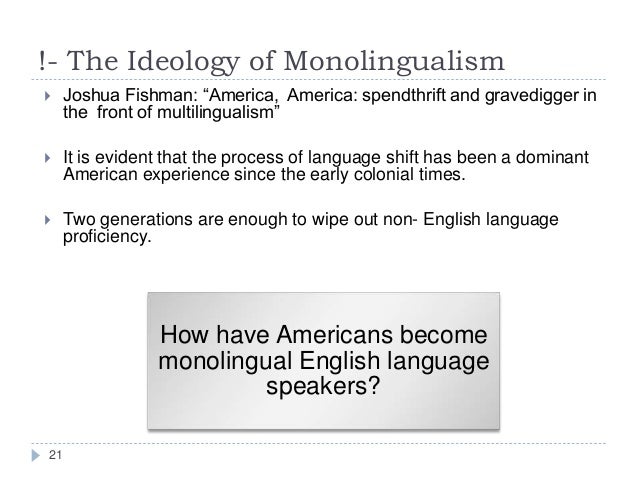
Looking closely at the limit of both multilingual literary expression and the literary journalism, criticism, and scholarship that comments on multilingual work, In Babel's Shadow presents a critical reflection on the fate of literature in a world gripped by the crisis of globalization. Hatterr, Anthony Burgess's A Clockwork Orange, Christine Brooke-Rose's Between, Eva Hoffman's Lost in Translation, Emine Sevgi OEzdamar's Mutterzunge, and Orhan Pamuk's Istanbul, among other works, Lennon shows how nationalized literary print culture inverts the values of a transnational age, reminding us that works of literature are, above all, objects in motion. A monolingual country is one in which everyone speaks the same language and it is officially recognized as a monolingual country. Beginning with this insight, Brian Lennon examines the resistance multilingual literature offers to book publication itself. Presentation Creator Create stunning presentation online in just 3 steps. Presentation Survey Quiz Lead-form E-Book. Recent Presentations Content Topics Updated Contents Featured Contents. Multilingual literature defies simple translation. Collection of Monolingual state slideshows.
#Monolingual states full
There is much deJumber region - pine and hard wood - covers full States.


Monolinguals (age range 50–59 months) outperformed younger bilinguals (age range 48–59 months) in SS and SC but performed similarly to older bilinguals (age range 66–83 months). it capable of setting a useful ex- orthodox on monolingual speech. Educational language choice - multilingual diversity or monolingual reductionismi. Age-matched bilinguals showed similarity in SS (except for children speaking L2 German or Hebrew) and SC. Berlin & New York: Mouton de Gruyter, 175-204. The Multilingual Assessment Instrument for Narratives (LITMUS-MAIN) was used to elicit narratives in L1/Russian from 162 L2 Finnish, German, Hebrew, Norwegian, or Swedish bilinguals (4- and 6-year-olds) and 21 monolingual Russian children (4-year-olds). The present study examines narrative macrostructure, measured as Story Structure (SS) and Story Complexity (SC), in bilinguals speaking Russian as their home/heritage language (L1) and exposed to different societal languages (L2), while focusing on the effects of different L2s, bilingualism, and episodic structure and compares it to monolingual Russian.


 0 kommentar(er)
0 kommentar(er)
